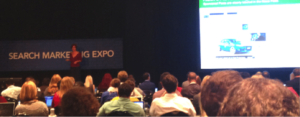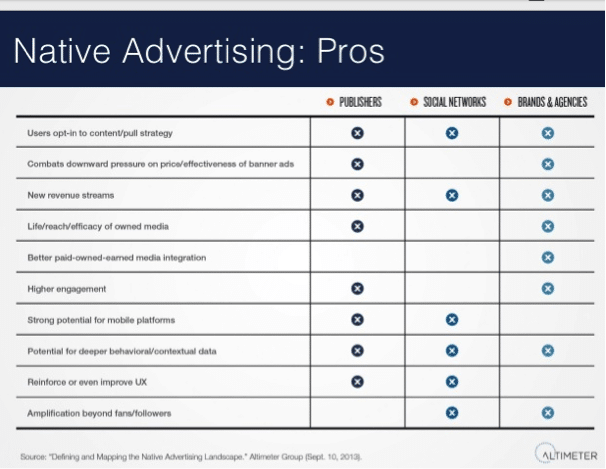HELLO Big Apple! It’s that time of year again: SMX East 2014, and our AIMCLEAR crew couldn’t be more excited to be here! We’ve been busy mingling & meeting new industry friends, staking claim with our content amplification tool debut, attending sessions, and enjoying our time in NYC.
Ready, Set, GO.

So, What Is It?
Altimeter Group defines “native advertising” as a form of a converged media that combines paid and owned media into a form of commercial messaging that is fully integrated into, and often unique to, any specific delivery platform. Not quite clear? Let’s keep digging.
They continue to define “owned” media as, “content that the brand or advertiser controls, while ‘paid’ media is advertising; very simply, this entails a media buy. On publisher sites, native advertising placements are congruent in look and feel to editorial. On Facebook, this could take the form of sponsored stories or Page Post ads, or on Twitter, promoted tweets.” Native advertising, or sponsored content, should be clearly labeled in every instance. Here are a few ad types that you may have seen before:
(Found on Mashable, BuzzFeed & AIMCLEAR‘s Facebook page)
“Content is the fuel of your marketing engine, and today – all good content – is social” –Rebecca Lieb
So, What’s Next?
Why should you be using native advertising? What are the benefits? With traditional digital advertising efforts, you may be starting to experience the following:
- Banner blindness – No one clicking
- Skipped pre-roll ads – No one watching
- Eroding email engagement rates
- Fragmented consumer attention
- Increased level of automation in programmatic digital advertising
- Downward price pressure on classic display advertising
Pros vs. Cons
By sharing your content in this form, you can experience 49x more clicks generated by Facebook Page Post ads than traditional ads at 45% less cost! Native advertising brings opportunities to social platforms, brands, agencies, technologies and publishers.
All newcomers to native advertising are vulnerable to the infancy of this digital strategy. Extra focus will have to be placed on education, training, transparency, disclosure and a greater emphasis on maintaining the authenticity that consumers expect from the publisher/platform.
What Do We Do Now?
To help deal with the risks and uncertainty, Rebecca highlights a few recommendations to help ensure success:
- Transparency & trust – It’s important to:
- Disclose that a placement is indeed a paid form of advertising
- Link to policies that explain such placement
- Provide a way for users to inquire
- Content Strategy:
- Make a plan – create a content strategy prior to initial promotion
- Be consistent with your voice, brand, edit and copy guidelines
- Seek approval from your content strategy team
- Collaboration: Get your teams (design, content, social, agencies, etc.) working together.
- Encourage internal collaboration
- Incentivize external contributions
- Ensure teams are agile, can learn/adapt quickly, and can apply what they’ve learned
- Earned Component:
- Finding new platforms/strategies to share and amplify content will greatly extend the campaigns’ reach and longevity
- Content Portability:Â Rebecca compares content to a Thanksgiving turkey: Slice it, share it, then turn it into soup the next day. Your content needs to be versatile & shareable
- Create content that can be shared in social
- Track content that resonates in social channels
- Maintain libraries of produced content that can be chopped and repurposed at the drop of a hat
- Training:
- Provide content strategy training at the brand level
- Train sales teams in native advertising offerings and benefits
- Train creative, account teams, media buyers & others in the advertising ecosystem on tactics and strategies
- Ability to Scale:
- Native advertising campaigns are usually “exclusive” and cannot be replicated elsewhere
- Publisher created content is often contractually limited to that publisher’s platform. Though, publisher created content can be exclusive (such as the NY Times), but advertisers can repost and promote
- Many vendor solutions do scale and travel, but at the expense of being native in the strictest sense.
- Measurement:
- Develop KPIs for each native campaign
- Use caution with overly publisher-centric metrics that gauge a campaigns performance
Hungry For More?
Grab a larger slice of the pizza pie by checking out this study performed by the Altimeter Group: Defining & Mapping The Native Advertising Landscape. We’re psyched to be here with the the best at SMX East 2014. Gretchen, signing off.













